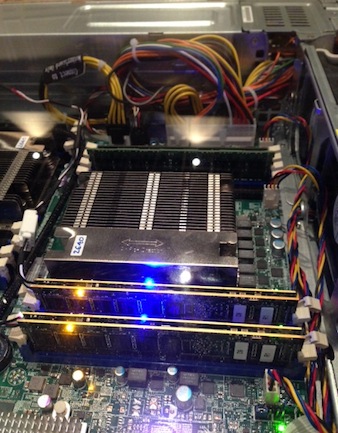Viking Technology is shipping a memory board that combines DRAM and NAND flash memory to create a non-volatile standard DIMM card that can be used in servers and storage arrays.
Viking's ArxCis-NV DIMM board has several purposes. With 10GB/s of throughput, it is roughly two and a half times faster than PCIe flash cards and can be used as another tier of high-speed storage. It can also used as a memory buffer for solid-state drives (SSDs) because of DRAM's ability to never wear out, no matter how many writes it receives. NAND flash memory in SSDs, however, has a limited life due to write amplification, a phenomenon in flash memory that requires data to be marked for deletion before it can be rewritten to another cell.
Adrian Proctor, Viking's vice president of marketing, said the NV DIMMs can actually extend the life of SSDs because they offload writes.
"This is all about performance," said Proctor, who was demonstrating the NVDIMM board at SNW here today. "This is not a replacement for SSDs. It's for use in conjunction with SSDs."
The NVDIMM can achieve up to 1.5 million 4K block I/Os per second or 10GB/s throughput, Proctor said.

Current cards are shipping to a couple of systems manufacturers with 8GB NAND flash, which is twice the amount of DRAM on the card.
Viking plans versions with 16GB later this year a 32GB version in 2014. Both will also have twice the amount of single-level cell (SLC) NAND flash than DRAM on the card. As Proctor explained, the cards don't need a lot of NAND flash capacity as they're acting as a cache for the DRAM in case of a system crash.
While today's server and array mother boards have capacitors that offer DRAM time to transfer data to flash or drives in the event of a crash, the difference in using an NV DIMM card is that applications can write directly to the DRAM with no threat of data loss and the benefit of a speedy recovery.
When a system is rebooted after a crash, it takes roughly 10 seconds per gigabyte of data to repopulate, Proctor said.
"For an 8GB NVDIMM, that's just over a minute while the rest of the system is spinning up. So it's effectively instant," he said.
An application specific integrated circuit (ASIC) on the board converts the DRAM data to the flash memory, where it can be stored or moved to SSD or disk drive storage.
Viking is not the only company coming out with the NVDIMM cards. In November, Micron announced a partnership with AgigA Tech, a subsidiary of Cypress Semiconductor Corp. to jointly develop an NV DIMM.
Micron demonstrated the first version of its NV DIMM, a 4GB model with 8GB of flash. AgigA supplied the ultracap power source that backs up the DRAM in case of a power failure, according to a Micron spokesperson.
Micron's current offerings include the aforementioned 8GB model and a 16GB version with 32GB of flash. A 16GB version with 32GB of flash is planned for later this year.
"Micron is the only supplier with the advantages of scale and stability," the spokesperson said in an email reply to Computerworld "Micron produces DRAM, NAND and NOR products, all which are used on the NVDIMM.
Micron also sees its NVDIMM card being used as a storage tier, as cache for RAID systems, system check pointing, full system persistence, data logging, de-duplication and fast access to metadata.
Without providing specifics, Proctor said the NVDIMM cards will cost roughly a few hundred dollars each, more than a standard DDR3 DIMM module but still inexpensive enough for server and storage admins to consider for application performance.
"I expect the big guys -- the Samsungs and Hynixs -- to come into this soon. We'll be having IP discussions with them and working with them to get these products out for mass adoption," Proctor said.





